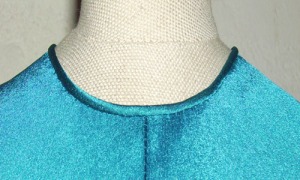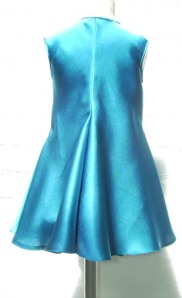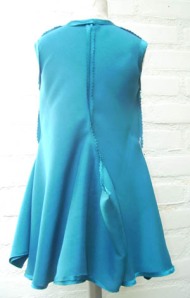The Pyramid dress pattern I ordered from center for pattern design because I was intrigued by the designs from the UK designer Julian Roberts.You can see him at work by watching 2 videos.

The pattern is made by Sandra Ericson and based upon the principles of Julian Roberts system of Subtraction Cutting.
I was interested to see how this pattern was drafted and to see how this design looked like in real which I could not really judge by the pattern design picture.
The pattern is partly drafted ( bodice part) you only need to draw the skirt portion which is a large circle around the pattern depending on the length you prefer.

Because this pattern needs one XL piece of fabric I tried this pattern by making it at ½ scale for my dress model so I had no piecing to do. I measured the pattern and draw a 1/2-scale pattern from it.
As you can see there are no seams in the skirt portion of the dress.It looks like a doughnut shape.
Pattern layout 1/2 scale size 12

The fabric I needed was 1.20 meter by 1.20 meter (1.312 x 1.312 yard) for my ½ scale pattern .So in other words if I would make this dress in a real size I need about 2.40 m by 2.40 m (2.624x 2.624 yard) that’s why you need to piece the fabric to get that wide.
Suggested bias fabrics: Loosely woven wools, silks or cotton; wool or silk crepe, crepe backed satin, silk velvet, georgette or chiffon.
I used stretch polyester satin for this unusual funky dress, and because it is only for showing on my scale dressmodel I did not finished the seams just use my pinking shear.
The instructions mention to sew stay tape at the shoulder seams to prevent stretching,I fused some pieces of fusible interfacing at the sharp angles at the partly side seams, and finished the armholes and neckline with binding finished wide 2 mm wide (0.078 inch) from bias cut self-fabric.
I stitched the bias cut strip of fabric right sides together at armhole and neckline and pressed the seams towards the bias cut piece, I folded the bias cut fabric around the seam allowance and hand stitched the piping in the ditch from the right side. Sewing it by hand gave me more control because of the small scale than using the sewing machine. Now there was no need to pin or baste first.


There was no need to leave an opening at center front because my ½ scale dress model has no head.But for a real size dress you need to leave an opening at the center back seam for 12,5 cm ( 5 inches)
The hem is uneven after sewing the dress and due to the bias cut I left it un hemmed for a few days.But you also can leave it as irregulare level but I choose for an even hem.



I marked the hemline with chalk using my lead measuring tape.

The hem wide is very wide 5.88 meter (nearly 6 ½ yard) at ½ scale and I finished it by just turning in and stitched from the wrong side a few hairlines away from the fold.This way it looks neat on the dress model but for a real size dress it is not a good way because the raffles are still there.
Inside view hem wide

Back view

 Front view
Front view
If you want a unique funky dress this is the one that you should make.
The sewing is easy, the pattern is printed on sturdy paper and the instructions are clear there are even some variations like using the side flaps to use as pockets.
PS. I am not planning to make this dress in my size, I only made it out of curiosity.
The cover dress picture has the folds at center front sewn differently, this is described in the pattern as variations on the theme.I folded the 4 corners flat at all the sides to achieve a more slimming view.
At the next pictures you can see the corners or cowls at the center, left, right and back of the dress.
inside side of the dress:



 Subscribe with Bloglines
Subscribe with Bloglines
Wow! What an incredible design. Great pictures.
Comment by Trudy Callan — August 10, 2009 @ 10:09 am
It’s certainly unique and funky but really, how many of us can wear a pyramid, especially those of us who are pyramidical in shape already. The Julian Robertssubtraction cutting is intriguing, though, thanks for the link.
Comment by Theresa in Tucson — August 10, 2009 @ 11:09 am
The results will be very different depending on what fabric quality you use. I think in the polyester satin the bias does not fall out as much as say a more loosely woven cotton or rayon. it would not stand away from the body as much.
Els, will you make this in full scale in a different fabric?
(I have cotton voile check fabric that is screaming to be cut on the bias – this pattern could make a good nightgown, because I wouldn’t go out of the house with it on – it’s too sheer.)
I seem to remember from a Sandra Ericson presentation on this pattern that the results differ according to which way you angle the cutouts for the bodice – you can turn the placement of the ‘negative space’ for the bodice to be CF bias grain or straight grain.
Comment by georgene — August 10, 2009 @ 11:36 am
Theresa is right. Interesting in theory, but it’s not a wearable dress. Or I might say, it’s a really ugly one.
Comment by sandra — August 10, 2009 @ 11:49 am
I am very intrigued Els. What an interesting, provocative pattern! Thanks for sharing it with us.
Comment by ConnieB — August 10, 2009 @ 11:52 am
It is very intriguing, especially the pattern layout which reminds me of drawing negative space exercises in art school. I agree that in a softer fabric it would fall closer to the body. Are you going to make it full sized Els?
Comment by Nancy K — August 10, 2009 @ 12:02 pm
What an amazing dress!
Comment by Tamara — August 10, 2009 @ 12:40 pm
This is interesting. Thinking outside of the box. What you have is a full circle skirt with a bodice that is fitted in the bust area, all cut in one. I immediately thought, put a belt around the waist and this could be a sharp looking dress. I don’t like those loose flaps hanging on the inside of the dress and think they should be controlled somehow. Perhaps turning them into big pleats.
Comment by Mpressive Threadz — August 10, 2009 @ 1:00 pm
Thanks for sharing your ideas.
A colleague had another idea to sew the front and back flaps together which will make a sort of pant skirt/dress.
There are lots of possibilities with this design.
Comment by Els — August 10, 2009 @ 1:25 pm
This is extremely interesting, thank you, Els. It reminds me of the books “Pattern Magic”, and the dress certainly has the feel of some of the high-end Japanese designers. As others have mentioned it’s not the most figure-flattering unless you’re a stick. Maybe it’s possible to change the fitting lines, making it more of a gored effect below the waist? This has given me food for thought :))
Comment by Birgitte — August 10, 2009 @ 2:13 pm
I agree that the concept is fun.
I would like to see this done with a princess seam line bodice that was not cut down center front–
that way the excess fabric would be in the side front seam lines.
Comment by Jen — August 10, 2009 @ 3:54 pm
Hmmm. Very interesting. I think it is rather plain as is, but there is certainly room for variation in neckline, embellishments, and certianly fabrication. Actually this would be a great pattern for a quilted garment, because it could be quilted all in one piece, the sections cut out for the bodice and then finished.
Comment by Summerset — August 10, 2009 @ 5:27 pm
What an interesting dress, Els. It reminds me of the “Pattern Magic” books as well. I can see how it is not the most figure flattering dress in this configuration, but I would think that fabric would make a big difference. Besides, if comparing it to the Japanese designers, some of those garments are not the most figure-flattering either, or they make us look at what is figure-flattering in a different light.
Comment by Mardel — August 11, 2009 @ 5:43 am
Great post. I think the dress is beautiful – your fabric choice was really good. The inside hem wiew looks so beautiful. I like that you made this just to satisfy your curiosity.
Comment by Gry — August 11, 2009 @ 8:05 am
Many thanks to Els for making up the Pyramid Dress! — It was named for The Pyramids in Indianapolis where it was first introduced and also the construction process of drawing it up from the middle. The original was made of wool basket-weave fabric, loosely woven, and in the manner of Vionnet, the fit in the bodice results from the weight of the skirt. The heavier the skirt (greater yardage), the more closely fitted — also full scale has a greater weight/fit effect. I opened the front pleat, creating a slit in the skirt and made the side pleats into pockets; the instruction for that is in the pattern. Love the idea of the princess seams — I’ll do a variation — have fun with it!
Comment by Sandra Ericson — August 11, 2009 @ 10:46 am
Very good pattern making design. I agree with most people here. It is an Absolutely ugly dress. Doesn’t have a great shape, and not flattering.
Fabric wise, I was thinking maybe nice silk charmeuse might work very well? not sure.
great job sewing on 1/2 scale though. and thanks for sharing the website
Comment by mike — August 11, 2009 @ 11:20 am
I don’t think its ugly *at all* and I really like it! The voluminous skirt is very beautiful in the way the fabric is allowed to drape naturally on the bias with no seaming. I can see this as a spectacular dress for a little girl, heirloom yet avant garde. In a toddler size it would not be hard to find fabric wide enough, and the bodice just cries out for lace and Swiss embroidery insertions. If it was me doing it the insertions would meet at the center front seam in a V to set off the bias draping.
Comment by Phyllis — August 13, 2009 @ 6:01 am
Great thinking Phyllis!
Comment by Mary Beth — August 13, 2009 @ 6:48 am
Thank you for all the great pictures and your review. I love to see this sort of great design.
Comment by Claire — August 14, 2009 @ 9:38 pm
Els, thanks for sharing this. Your Postings are always very enlightening. I think this dress is wonderful, and I like ‘different’ and unusually architectural styles e.g. I. Miyake. Full length in a soft silk and it would be a ‘show stopper’. If I had the time I would experiment with this pattern, maybe later when time allows.
You always take us to the next higher level. Thanks!
Comment by Gemma — August 16, 2009 @ 3:13 am
Some very interesting points have been made here, it is refreshing to see that your site gets quality visitors.
Good to see that people still know what they are talking about. So much BS around these days!
Love the new look, keep up the great work the number of visitors must have increased?.
Comment by sewing fabrics — August 16, 2009 @ 6:01 am
Thanks to all who commented, and shared ideas.
A special thank you to Sandra Ericson who made this pattern and her explanation about the construction process of drawing it up from the middle. see comment 14.
The light weight fabric I used for this dress has the same hand and weight as a silk charmeuse.
I hope to make this pattern in a real size for someone who is slim and tall some day because it is a unique dress design.
Comment by Els — August 16, 2009 @ 6:59 am
Breathtaking. I understand why you felt so intrigued about this dress
Comment by Tany — August 16, 2009 @ 8:26 pm
What a neat idea. There’s no way on this earth I could wear that dress as-is but it certainly sparks some ideas. Imagine it made up as a evening gown with the body cut out through the hips then flowing out. Or with the bodice cut in 8 pieces and/or the godets (right word?) tacked into place as box pleats at the top. I’m not sure if any of these ideas are “flattering” but the cut really does make you think about the process and fit and shape. Thank you for posting this!
Comment by Kit — October 21, 2009 @ 2:14 pm
some great info here
i am adding this to my bookmarks…
Comment by maggie roper — January 20, 2010 @ 4:29 am
Hi from Paris. Really it’s a real nice and so interesting blog.Thanks a lot. I sew my clothes since…I can’t remember. I love to experiment new art of sewing. I am very impressionned with this substraction cutting technique. Unfortunatly, I am not sure to understand it well…For example, for the 7 holes substraction dress pattern…how to sew the holes? and how to sew all togather???? I love drape. I have seen the exibition at the museum in Paris from Madeleine Vionnet. Wonderful. Unfortunatly, I am a self experiment sewer. I can read and sew “normal” pattern…not exactly as it has to be done, but it works…Drape is a dream…japanese designer like Miyake, comme des garçons etc are “unreachable” for me…I am wondering how to make some drape, and pleats and amazing and “notunderstanding” clothes like skirt trousers, coat you can wear up or down side etc…I am not afraid to wear that crazy things, if it’s associate with a classic jacket or trousers. It make me smile to see some interrogating faces…but what’s that??? Again thanks to share all the beautiful things you do. Excuse my bad english…school is too far away. Bye. Gudule26
Comment by Gudule26 — March 11, 2010 @ 7:29 am
You can order a pattern The Smaller Dress by Julian Roberts from centerforpatterndesign.com, which has instructions how to sew the dress, included the holes. http://www.centerforpatterndesign.com/products/THE-SMALLER-DRESS-by-Julian-Roberts.html
See also a youtube video `Subtraction Dress` http://www.youtube.com/watch?v=uUGkQ8oezSg
For more information about Julian Roberts Subtraction cutting
http://www.centerforpatterndesign.com/products/SCHOOL-OF-SUBTRACTION-CUTTING-by-Jullian-Roberts.html
Comment by Els — March 14, 2010 @ 10:50 am